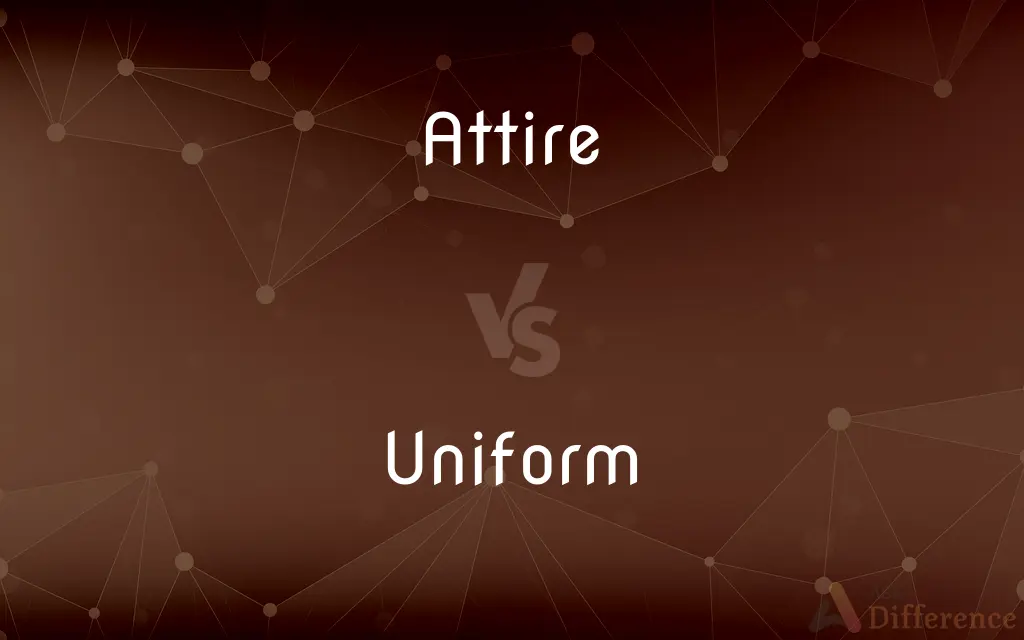Attire vs. Uniform — What's the Difference?
By Fiza Rafique & Maham Liaqat — Updated on March 29, 2024
"Attire" refers to clothing worn for specific occasions or purposes, highlighting individual choice, while "Uniform" is standardized dress prescribed for members of a group, emphasizing conformity.

Difference Between Attire and Uniform
Table of Contents
ADVERTISEMENT
Key Differences
Attire encompasses a wide range of clothing options chosen by individuals based on personal taste, occasion, or cultural norms. It reflects personal style and the context in which it is worn, such as formal attire for a wedding or casual wear for everyday activities. On the other hand, a uniform is a specific set of clothing that must be worn by members of a particular organization, institution, or group, designed to promote unity and easily identify affiliations.
The purpose of attire is often to express individuality or adhere to social and cultural expectations for a particular setting. Whereas uniforms serve to eliminate distinctions among members of a group, fostering a sense of belonging and equality. This distinction underlines the role clothing plays in personal versus collective identity.
In terms of flexibility, attire offers a range of choices within the bounds of appropriateness for the occasion, allowing for personal expression through fashion. In contrast, uniforms have strict guidelines regarding style, color, and often the manner of wear, leaving little room for individual preference or deviation.
The selection of attire is influenced by factors such as personal taste, cultural background, and the nature of the event, allowing individuals to convey messages about their identity or status. Uniforms, however, are determined by the policies of the organizing body and aim to convey a unified image or brand of the group, institution, or company.
While attire can change based on trends, personal preference, or the evolving nature of social norms, uniforms tend to remain consistent over time, providing a stable and recognizable image for the organization it represents. This consistency helps in building a strong visual identity but may require periodic updates to reflect changes in the organization’s branding or practical needs.
ADVERTISEMENT
Comparison Chart
Definition
Clothing worn for specific occasions or purposes.
Standardized dress prescribed for members of a group.
Purpose
To express individuality or adhere to social norms.
To promote unity and identify affiliations.
Flexibility
Offers choice within appropriateness for the occasion.
Strict guidelines with little room for deviation.
Influence
Personal taste, cultural background, event nature.
Policies of the organizing body.
Change and Evolution
Subject to trends, preferences, social norms.
Consistent over time but may update for branding.
Compare with Definitions
Attire
Reflects personal style.
Her attire always includes vibrant colors.
Uniform
Represents an organization.
Employees wear uniforms bearing the company logo.
Attire
Adapts to trends.
Casual attire has become more acceptable in workplaces.
Uniform
Prescribed dress for group members.
The school uniform includes a blue blazer.
Attire
Varies by occasion.
The invitation specified smart casual attire.
Uniform
Has strict guidelines.
The airline's uniform policy specifies shoe types.
Attire
Clothing worn for specific settings.
The gala required formal attire.
Uniform
Promotes unity.
Team uniforms help in identifying players during a match.
Attire
Can be culturally influenced.
Traditional attire was worn during the festival.
Uniform
Rarely changes.
The military uniform has remained the same for decades.
Attire
To dress or clothe, especially in fine or elaborate garments.
Uniform
A uniform is a type of clothing worn by members of an organization while participating in that organization's activity. Modern uniforms are most often worn by armed forces and paramilitary organizations such as police, emergency services, security guards, in some workplaces and schools and by inmates in prisons.
Attire
Clothing or array; apparel.
Uniform
Always the same, as in character or degree; unvarying
Planks of uniform length.
Attire
The antlers of a deer.
Uniform
Being the same as or consonant with another or others
Rows of uniform brick houses.
Attire
(clothing) One's dress; what one wears; one's clothes.
He was wearing his formal attire.
Uniform
A distinctive set of clothing intended to identify the members of a specific group
A police uniform.
Attire
(heraldry) The single horn of a deer or stag.
Uniform
To make (something) uniform.
Attire
(transitive) To clothe or adorn.
We will attire him in fine clothing so he can make a good impression.
He stood there, attired in his best clothes, waiting for applause.
Uniform
To provide or dress with a uniform.
Attire
To dress; to array; to adorn; esp., to clothe with elegant or splendid garments.
Finely attired in a robe of white.
With the linen miter shall he be attired.
Uniform
Unvarying; all the same.
Attire
Dress; clothes; headdress; anything which dresses or adorns; esp., ornamental clothing.
Earth in her rich attire.
I 'll put myself in poor and mean attire.
Can a maid forget her ornament, or a bride her attire?
Uniform
Consistent; conforming to one standard.
Attire
The antlers, or antlers and scalp, of a stag or buck.
Uniform
(mathematics) with speed of convergence not depending on choice of function argument; as in uniform continuity, uniform convergence
Attire
The internal parts of a flower, included within the calyx and the corolla.
Uniform
Composed of a single macromolecular species.
Attire
Clothing of a distinctive style or for a particular occasion;
Formal attire
Battle dress
Uniform
(geometry) (of a polyhedron) That is isogonal and whose faces are regular polygons; (of an n-dimensional (n>3) polytope) that is isogonal and whose bounding (n-1)-dimensional facets are uniform polytopes.
Attire
Put on special clothes to appear particularly appealing and attractive;
She never dresses up, even when she goes to the opera
The young girls were all fancied up for the party
Uniform
A distinctive outfit that serves to identify members of a group.
Uniform
(international standards) nodot=1 NATO/ICAO Phonetic Alphabet.}}
Uniform
(police) A uniformed police officer (as opposed to a detective).
Uniform
(transitive) To clothe in a uniform.
Uniform
Having always the same form, manner, or degree; not varying or variable; unchanging; consistent; equable; homogenous; as, the dress of the Asiatics has been uniform from early ages; the temperature is uniform; a stratum of uniform clay.
Uniform
Of the same form with others; agreeing with each other; conforming to one rule or mode; consonant.
The only doubt is . . . how far churches are bound to be uniform in their ceremonies.
Uniform
A dress of a particular style or fashion worn by persons in the same service or order by means of which they have a distinctive appearance; as, the uniform of the artillery, of the police, of the Freemasons, etc.
There are many things which, a soldier will do in his plain clothes which he scorns to do in his uniform.
Uniform
To clothe with a uniform; as, to uniform a company of soldiers.
Uniform
To make conformable.
Uniform
Clothing of distinctive design worn by members of a particular group as a means of identification
Uniform
Provide with uniforms;
The guards were uniformed
Uniform
Always the same; showing a single form or character in all occurrences;
A street of uniform tall white buildings
Uniform
The same throughout in structure or composition;
Bituminous coal is often treated as a consistent and homogeneous product
Uniform
Not differentiated
Uniform
Evenly spaced;
At regular (or uniform) intervals
Common Curiosities
Why are uniforms important?
Uniforms promote unity, equality among members, and identify affiliations.
What role does a uniform play in an organization?
It creates a cohesive appearance, supports branding, and can enhance professionalism.
What is the main purpose of wearing attire?
To express individuality or adhere to social and cultural expectations for specific settings.
How often should attire be updated?
Attire updates depend on personal preference, changes in trends, or the evolving nature of social norms.
Can attire be a uniform?
Yes, if the attire is standardized and prescribed for a group, it can serve as a uniform.
Is it mandatory to follow attire guidelines for events?
While not mandatory, following attire guidelines shows respect for the event's norms and hosts.
Are there penalties for not adhering to uniform policies?
Organizations may implement penalties for non-compliance with uniform policies to maintain consistency and discipline.
Can uniforms affect an individual's identity?
Yes, by minimizing personal expression in favor of group identity, but they can also instill pride and belonging.
Why might someone prefer custom attire?
For a more personalized expression that aligns with their identity or to stand out in a specific setting.
How does attire reflect personal style?
Attire reflects personal style through choices in color, design, and fit tailored to individual preferences.
How do uniforms help in identifying affiliations?
Uniforms bear specific designs, colors, and logos that easily signify an individual's group or organizational affiliation.
What factors influence the choice of attire?
Personal taste, cultural norms, occasion, and current fashion trends.
What is the significance of uniformity in certain professions?
Uniformity can denote authority, ensure safety, and foster a professional atmosphere conducive to discipline and order.
How can uniforms contribute to team spirit?
By wearing the same outfit, members feel a stronger sense of unity and shared purpose.
Can uniforms change over time?
Yes, but changes are usually infrequent and often due to branding updates or practical requirements.
Share Your Discovery

Previous Comparison
Jigsaw vs. Hacksaw
Next Comparison
Hall vs. PorchAuthor Spotlight
Written by
Fiza RafiqueFiza Rafique is a skilled content writer at AskDifference.com, where she meticulously refines and enhances written pieces. Drawing from her vast editorial expertise, Fiza ensures clarity, accuracy, and precision in every article. Passionate about language, she continually seeks to elevate the quality of content for readers worldwide.
Co-written by
Maham Liaqat













































